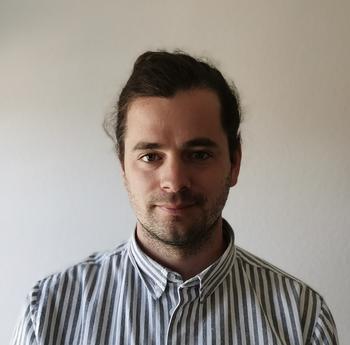Prof. Dr. Adrien Doerig

Cognitive Computational Neuroscience lab
Guest Professor
Room JK 25/220
14195 Berlin
Master Cognitive Neuroscience
-
Probability and statistical modelling (theoretical)
-
Probability and statistical modelling (practical, focussing on ANNs and neuroimaging analysis)
-
Introduction to programming
-
Applied computational cognitive neuroscience
-
Cognitive neuroscience: Vision
-
Cognitive neuroscience: Language, affective & social neuroscience
-
Cognitive neuroscience: Consciousness
Bachelor courses
-
Experimental Practical (EXPRA) for Psychology BSc Students
Publications
Preprints / under review
Paßler, M., & Doerig, A. (2024). Neurophenomenal Structuralism and the Role of Computational Context. arXiv preprint arXiv:2412.20873. https://arxiv.org/abs/2412.20873
Piefke, L., Doerig, A., Kietzmann, T., & Thorat, S. (2024). Computational characterization of the role of an attention schema in controlling visuospatial attention. arXiv preprint arXiv:2402.01056.
Lu, Z. †, Doerig, A. †, Bosch, V. †, Krahmer, B., Kaiser, D., Cichy, R. M., & Kietzmann, T. C. (2023). End-to-end topographic networks as models of cortical map formation and human visual behaviour: moving beyond convolutions. arXiv preprint arXiv:2308.09431. https://arxiv.org/abs/2308.09431v1
Doerig, A., Kietzmann, T.C., Allen, E., Wu, Y., Naselaris, T., Kay, K. & Charest, I. (2022). Semantic scene descriptions as an objective of human vision. Arxiv. Open access link: https://doi.org/10.48550/arXiv.2209.11737
Herzog, M. H., & Doerig, A. (2021). Why our best theories of perception and physics undermine realism. PsyArXiv. Open access link: https://psyarxiv.com/r4sf9
Publications in peer-reviewed scientific journals
Doerig, A. †, Sommers, R. P. †, Seeliger, K., Richards, B., Ismael, J., Lindsay, G. W., ... & Kietzmann, T. C. (2023). The neuroconnectionist research programme. Nature Reviews Neuroscience, 1-20. https://t.co/xHQyUXXhdA
Golan, T., Taylor, J., Schütt, H., Peters, B., Sommers, R. P., Seeliger, K., Doerig, A,... & Kriegeskorte, N. (2023). Deep neural networks are not a single hypothesis but a language for expressing computational hypotheses. Behavioral and Brain Sciences, 46.
Herzog, M. H., Doerig, A., & Sachse, C. (2023). Why computational complexity may set impenetrable barriers for epistemic reductionism. Synthese, 202(5), 136.
Bornet, A. †, Doerig, A. †, Herzog, M. H., Francis, G., & Van der Burg, E. (2021). Shrinking Bouma’s window: How to model crowding in dense displays. PLOS Computational Biology, 17(7), e1009187. https://doi.org/10.1371/journal.pcbi.1009187
Lonnqvist, B., Bornet, A., Doerig, A., & Herzog, M. H. (2021). A comparative biology approach to DNN modeling of vision: A focus on differences, not similarities. Journal of Vision, 21(10), 17-17. Open access link: https://doi.org/10.1167/jov.21.10.17
Herzog, M. H., Schurger, A., & Doerig, A. (2021). First-person experience cannot rescue causal structure theories from the unfolding argument. Consciousness and Cognition. Open access link: https://doi.org/10.1016/j.concog.2021.103261
Bornet, A., Choung, O. H., Doerig, A., Whitney, D., Herzog, M. H., & Manassi, M. (2021). Global and high-level effects in crowding cannot be predicted by either high-dimensional pooling or target cueing. Journal of Vision, 21(12), 10-10. Open access link: https://doi.org/10.1167/jov.21.12.10
Choung, O. H., Bornet, A., Doerig, A., & Herzog, M. H. (2021). Dissecting (un) crowding. Journal of vision, 21(10), 10-10. Open access link: https://doi.org/10.1167/jov.21.10.10
Herzog, M. H., Drissi-Daoudi, L., & Doerig, A. (2020). All in Good Time: Long-Lasting Postdictive Effects Reveal Discrete Perception. Trends in Cognitive Sciences. https://doi.org/10.1016/j.tics.2020.07.001
Michel, M. †, & Doerig, A. † (2020). A new empirical challenge for local theories of consciousness. Mind & Languge. https://philpapers.org/archive/MICANE-2.pdf
Doerig A.†, Schmittwilken L.†, Sayim B., Manassi M., Herzog M. H. (2020) Capsule networks as recurrent models of grouping and segmentation. PLoS Comput Biol 16(7): e1008017. https://doi.org/10.1371/journal.pcbi.1008017
Doerig A., Schurger A., Herzog M. H. (2020) Hard criteria for empirical theories of consciousness. Cognitive Neuroscience. 2020; 1–22. https://doi:10.1080/17588928.2020.1772214
Doerig, A. †, Bornet, A. †, Choung, O. H., & Herzog, M. H. (2020). Crowding Reveals Fundamental differences in Local vs. Global Processing in Humans and Machines. Vision Research, 167, 39-45. Link: https://doi.org/10.1016/j.visres.2019.12.006
Drissi-Daoudi, L., Doerig, A., Parkosadze, K., Kunchulia, M., & Herzog, M. H. (2020). How stable is perception in #TheDress and #TheShoe?. Vision Research, 169, 1–5. Link: https://doi.org/10.1016/j.visres.2020.01.007
Drissi-Daoudi, L. †, Doerig, A. †, & Herzog, M. H. (2019). Feature integration within discrete time windows. Nature communications, 10(1), 1-8. Open access link: https://doi.org/10.1038/s41467-019-12919-7
Doerig, A., Scharnowski, F., & Herzog, M. H. (2019). Building perception block by block: a response to Fekete et al. Neuroscience of consciousness, 2019(1), niy012. Open access link: https://doi.org/10.1093/nc/niy012
Doerig, A., Schurger, A., Hess, K., & Herzog, M. H. (2019). The unfolding argument: Why IIT and other causal structure theories cannot explain consciousness. Consciousness and Cognition, 72, 49-59. Open access link: https://doi.org/10.1016/j.concog.2019.04.002
Doerig, A., Bornet, A., Rosenholtz, R., Francis, G., Clarke, A. M., & Herzog, M. H. (2019). Beyond Bouma's window: How to explain global aspects of crowding?. PLOS Computational Biology, 15(5), e1006580. Open access link: https://doi.org/10.1371/journal.pcbi.1006580
Drissi-Daoudi, L., Doerig, A., Parkosadze, K., Kunchulia, M., & Herzog, M. H. (2017). The role of one-shot learning in #TheDress. Journal of Vision, 17(3):15, 1–7, doi:10.1167/17.3.15. Open access link: https://doi.org/10.1167/17.3.15
Pachai, M. V., Doerig, A., & Herzog, M. H. (2016). How best to unify crowding?. Current Biology, 26(9), R352-R353 Open access link: https://doi.org/10.1016/j.cub.2016.03.003
† Equal contributions
Peer-reviewed conference proceedings
Doerig, A., Kirubeswaran, O.R., Kietzmann, T.C. (2023). Keep moving: sensorimotor integration of fixational eye-movements yields human-like superresolution in recurrent neural networks. Computational Cognitive Neursoscience (CCN)
Lu, Z., Doerig, A., Bosch, V., Krahmer, B., Kaiser, D., Cichy, R., Kietzmann, T.C. (2023). The brain can’t copy-paste: End-to-end topographic neural networks as a way forward for modelling cortical map formation and behaviour. Computational Cognitive Neursoscience (CCN)
Thorat, S., Doerig, A., Kietzmann, T.C. (2023) Characterising representation dynamics in recurrent neural networks for object recognition. Computational Cognitive Neuroscience (CCN)
Choung, O.H. †, Doerig, A.†, Bornet, A., & Michael, M.H. (2019). Recurrent Architectures are Needed for Human-like Global Processing. NeurIPS workshop on Shared Visual Representations in Human and Machine Intelligence (SVRHM)
Doerig, A., Schmittwilken, L., Manassi, M., & Herzog, M. H. (2019). Towards Global Recurrent Models of Visual Processing: Capsule Networks. Conference on Cognitive Computational Neuroscience, Submission ID, 1066.